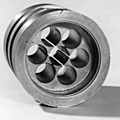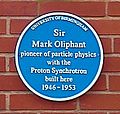Marcus Oliphant facts for kids
Sir Marcus “Mark” Laurence Elwin Oliphant, often known as Marcus Oliphant, was a famous Australian physicist and humanitarian. He was a very important scientist who helped create nuclear weapons. He also played a key role in showing for the first time how nuclear fusion could work.
Biography
Mark Oliphant was born on October 8, 1901, in Kent Town, Adelaide, Australia. His father, Harold George “Baron” Oliphant, worked for the government as a civil servant. His mother, Beatrice Edith Fanny Oliphant, was an artist.
After finishing Adelaide High School in 1918, Mark couldn't afford to go to university. So, he took a job cleaning floors at a jewelry store. Soon, he saved enough money to study at the University of Adelaide. He was interested in medicine at first. However, the physics professor, Kerr Grant, offered him a spot in the Physics Department. He earned his Bachelor of Science degree in 1921.
Oliphant later tried to build a large 60-inch (150-centimetre) cyclotron at the University of Birmingham. A cyclotron is a machine that speeds up tiny particles. Its completion was delayed because World War II started in Europe in 1939.
He was also involved in developing radar with other scientists, John Randall and Harry Boot. They created a completely new design called the cavity magnetron. This invention made microwave radar possible, which was very important during the war.
One of his most important achievements was helping with the development of the atomic bomb. He reported that building such a bomb was possible as early as 1943. He shared his research in the United States. This led to the start of the Manhattan Project, a secret research project led by physicist J. Robert Oppenheimer. This project created the first atomic bombs.
Mark Oliphant passed away on July 14, 2000, in Canberra, Australia.
Achievements and Recognition
Mark Oliphant is remembered for many important scientific discoveries. He helped discover deuterium, tritium, and helium-3. These are different forms of hydrogen and helium atoms. He also played a big part in the development of nuclear fusion and microwave radar.
Many places and things are named after him to honor his work:
- The Oliphant building at the Australian National University.
- The Mark Oliphant Conservation Park in South Australia.
- A science competition for high schools in South Australia.
- The Oliphant Wing of the Physics Building at the University of Adelaide.
- A high school in Munno Para West, South Australia.
He received many awards during his life for his contributions to science:
- 1937: He was elected a Fellow of the Royal Society.
- 1943: He received the Hughes Medal from the Royal Society.
- 1946: He was awarded the Silvanius Thomson Medal from the Institute of Radiology.
- 1948: He received the Faraday Medal from the Institution of Engineers.
- 1954: He was elected a founding Fellow of the Australian Academy of Science.
- 1954: He was also elected the first President of the Australian Academy of Science.
- 1955: He was invited to give the Bakerian Lecture by the Royal Society.
- 1955: He was also invited to give the Rutherford Memorial Lecture by the Royal Society.
- 1956: He received the Galathea Medal from King Frederick IX of Denmark.
- 1959: He was made a Knight Commander of the Order of the British Empire.
- 1977: He was appointed a Companion of the Order of Australia.
Images for kids
-
Oliphant (left), Homi Jehangir Bhabha (center), and Philip Baxter (right) meeting in 1954.
-
The Poynting Physics building at the University of Birmingham.
-
The original cavity magnetron, developed by John Randall and Harry Boot.
-
The giant Alpha I racetrack at Y-12 in Oak Ridge, Tennessee, used for separating materials.
-
The remains of the 500 MJ generator at the Australian National University.
-
A plaque about Mark Oliphant on the Jubilee 150 Walkway.
See also
 In Spanish: Mark Oliphant para niños
In Spanish: Mark Oliphant para niños













